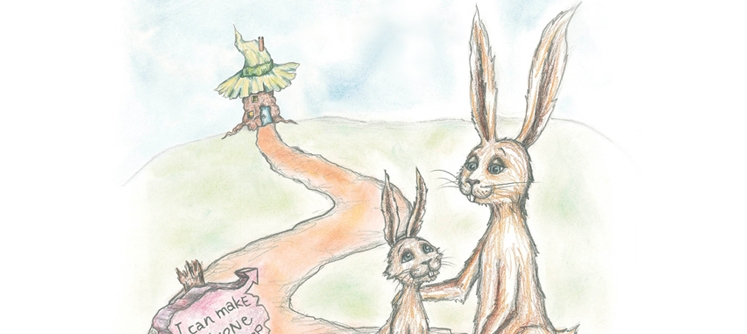Fed up of long, tiresome nights getting your child ready for bedtime?
One Swedish psychologist is on a mission to change all that.
Carl-Johan Forssén Ehrlin is the author of the best-selling children’s book, The Rabbit Who Wants to Fall Asleep. Using very specific language patterns and hypnotic cues (yawning…etc) to help children fall asleep faster, the book is one of the most unusual titles to hit shelves in recent years.
Telling the story of a rabbit who can’t fall asleep, Roger is soon taken by Mummy Rabbit to see Uncle Yawn, who knows exactly what to do. The setup is simple enough, but plenty of research has gone into ensuring it actually works, as proven by its glowing testimonials from frustrated parents, expert validation and the subsequent media explosion.
So, who is the Scandinavian saviour to whom parents could soon owe their night-time peace? Well Carl-Johan is a man whose life was transformed after being given a bag full of self-development tapes a friend originally intended to throw away. Deciding to study the behavioural psychology behind the tapes at university, he has since moved onto writing books and even life-coaching and leadership training.
Ironically, for someone who has written a book intended to create a sleepy lull, Carl-Johan has a confident, upbeat and ‘glass half-full’ air as he sits comfortably in his chair, awaiting my first question.
What were the biggest challenges about converting psychological ideas into a children’s book?
As soon as I had the idea, I just knew how I was supposed to write the book. The main thing was using my experience in a children’s book, without it being too boring or too exciting. It was a challenge to make sure there was a balance between the two.
Should parents see this as a resource rather than a traditional story book?
Maybe it is more like a tool than a book. Some parents say “Oh, we don’t want to read this, it takes away the nice time while children fall asleep.” But other parents read their children’s favourite books first, then say “Ok, now it’s time to fall asleep”, and they read the rabbit book last.
Can it help give children the self-reliance they need to go asleep on their own?
In the text, I try to teach the child to relax themselves by giving them techniques to use. My goal is for them not to need the book eventually. Maybe you can also enhance that as a dad. Say, one evening when it’s time to let go of the book, you can just talk about the rabbit: “Do you remember what the rabbit did to fall asleep?” You just keep reminding them how it made them feel and gradually phase it out.
So could the methods from the book be used in other aspects of parenting?
I know some parents who have seen the patterns in the book – how I use language and so forth – and they’ve used it in other areas. One reader just made up a story based around the ideas from the rabbit book, and her child stopped drinking milk in the evening the first time she tried it. She just copied my thoughts of how to interact with her child.
Has becoming a father affected your appreciation of the book?
It’s gone pretty well [with our son]. We would play the audiobook in the room as we were going to sleep so he could fall asleep listening to that. He’s two now and we played the audiobook from the beginning, then we just played it when he has trouble going to sleep or just relaxing in general. So, making it part of their bed routine is really important.
The book was originally self-published, are you proof that positive things can happen through that process?
Yes! I’m keeping the rights for Sweden, so we’re still self-publishing there because we like to work with bookshops and meet the people who buy them directly. I think self-publishing is a great opportunity for people to get their book out there and just start believing in their dream. The important thing is “does the book fulfil its purpose?” Just try it and really give it a go!
Some parents say this feels like hoodwinking their child into going to sleep. Thoughts?
Well, we manipulate our children all the time: “please have one more bite for daddy, one more for mummy.” We try all these things but I don’t see it that way. I see it more as introducing the child to whether they want to relax or not. So for me it was like building relaxation or meditation. The main thing is not making it boring for the child so they’re still intrigued.
Dads can be more self-conscious than mums about putting on voices and acting out the book as they read. Any tips?
That can also be a negative in that they can overdo it sometimes. That’s the feedback I get from mums: “When my husband is reading, he’s doing all these voices and really emphasising everything, and it doesn’t work. Then I read and it works because it’s more relaxing.” So you don’t want to create too much drama, you want to maybe do a calmer rabbit voice. As a parent, you need to be in a relaxed state as well because they’ll pick up on that!
 What is the best advice you have for getting the most out of your book?
What is the best advice you have for getting the most out of your book?
I think it’s important to observe your child as you read this story and adapt the book to how the child is reacting. The book recommends how to read it but it’s not a text you can’t change. You have to be playful, you can take away stuff or add stuff, whatever helps your child relax. As a dad, you should be like a scientist: “What happens if I do this?” For instance, “What if my child complains their name isn’t in the story?” Just add their name!
The Rabbit Who Wants to Fall Asleep is published by Ladybird Books and is available in paperback for £7.99.




























